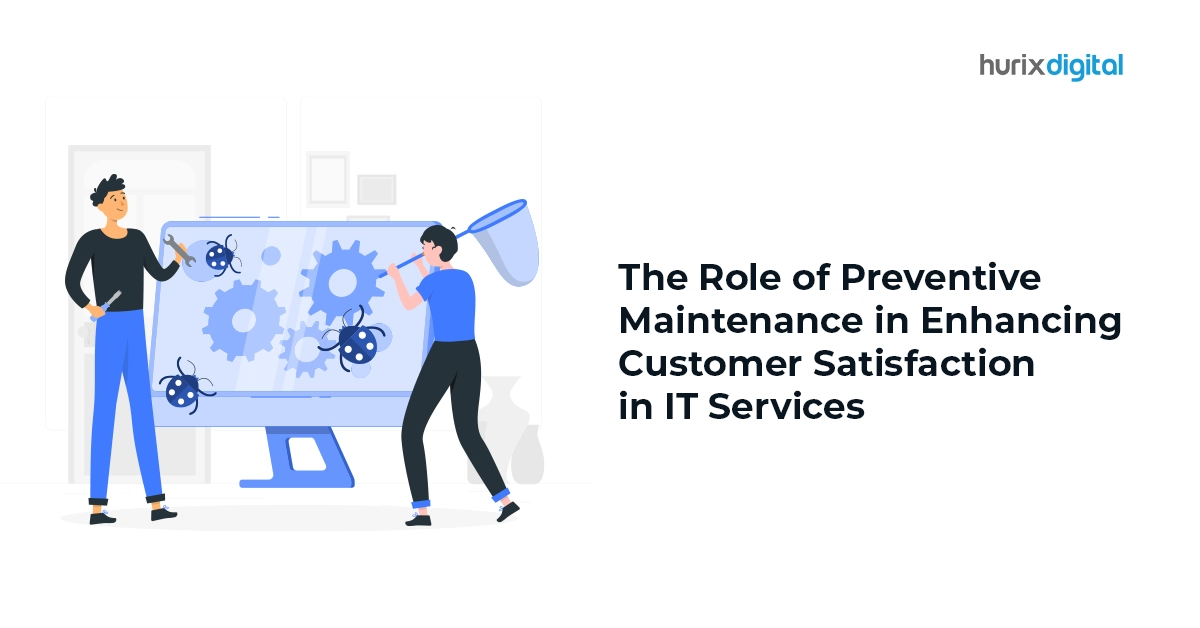
The Role of Preventive Maintenance in Enhancing Customer Satisfaction in IT Services
Summary
Learn about the importance of preventive maintenance in IT services. This article discusses how proactive maintenance can improve customer satisfaction and service reliability.
Preventive maintenance of any IT infrastructure is a weapon to ensure uninterrupted operations and optimal performance. Regular inspections, updates, and checks of hardware components such as servers, switches, and routers help identify and rectify potential issues before they escalate into critical failures.
Software systems require timely patches, updates, and security audits to mitigate vulnerabilities and safeguard against cyber threats. Scheduled backups and data integrity checks further fortify the infrastructure against data loss or corruption. By proactively addressing potential problems, preventive maintenance minimizes downtime, enhances reliability, and extends the lifespan of IT assets, ultimately supporting the organization’s efficiency and competitiveness.
Let’s explore the role of preventive maintenance and how it boosts your business!
Table of Contents:
- What is Preventive Maintenance in Cloud Computing
- When to Perform Preventive Maintenance Activities?
- How Customer Satisfaction Can Be Assured Due to Preventive Maintenance?
- Conclusion
What is Preventive Maintenance in Cloud Computing
Preventive maintenance in cloud computing refers to a set of proactive measures taken to maintain the health, performance, and security of cloud-based systems and resources. This approach involves regular monitoring, analysis, and optimization of cloud infrastructure to prevent potential issues before they arise and impact operations. The important thing to note is when it comes to the cloud, we don’t need to worry about the maintenance of hardware it’s taken care of by vendors who provide cloud services.
Some of the key aspects of preventive maintenance programs in cloud computing include:
- Resource Monitoring and Scaling: Continuous monitoring of resource utilization and performance metrics enables proactive scaling of resources to accommodate changing demand patterns, ensuring optimal performance and cost-efficiency.
- Patch Management: Regular application of patches and updates to virtual machines, containers, and underlying infrastructure helps to address security vulnerabilities and software bugs, reducing the risk of cyber threats and system failures.
- Security Audits and Compliance Checks: Regular security audits and compliance assessments help identify and remediate security gaps and ensure adherence to industry regulations and best practices, safeguarding sensitive data and maintaining trust with customers.
- Data Backup and Disaster Recovery: Implementing robust backup and disaster recovery strategies ensures data availability and integrity in the event of unexpected outages, data loss, or cyber-attacks, minimizing downtime and business disruption.
- Performance Optimization: Analysing performance bottlenecks and tuning configurations of cloud services and applications enhances overall system efficiency, responsiveness, and scalability, optimizing user experience and resource utilization.
- Proactive Troubleshooting: Utilizing monitoring tools and automated alerts enables early detection of potential issues, allowing for timely intervention and resolution before they escalate into critical problems that impact service availability and user satisfaction.
By proactively addressing these aspects, preventive maintenance in cloud computing helps organizations maximize the reliability, security, and performance of their cloud-based infrastructure, supporting their business objectives and enabling innovation and growth.
Also Read: The Role of Web Hosting in Website Development: Shared, VPS, Dedicated, and Cloud Hosting
When to Perform Preventive Maintenance Activities?
Performing preventive maintenance activities for cloud infrastructure involves strategic planning and regular scheduling to ensure optimal system health and performance. Here are some key timings for conducting these activities:
- Scheduled Maintenance Windows: Plan regular maintenance windows during off-peak hours or low-demand periods to minimize disruption to users. This could include activities such as applying software updates, patches, and security fixes to cloud instances and services.
- Before Significant Changes: Perform preventive maintenance before implementing significant changes or updates to the cloud infrastructure, such as scaling up/down resources, deploying new applications, or modifying network configurations. This helps ensure that the environment is stable and properly configured to support the changes without unexpected issues.
- Regular Intervals: Establish a schedule for routine preventive maintenance activities, such as security audits, performance optimizations, and backup validations. These activities should be performed at regular intervals to proactively identify and address potential issues before they impact system reliability or security.
- During Planned Downtime: Take advantage of planned downtime during scheduled maintenance windows or system upgrades to conduct more extensive preventive maintenance tasks that may require temporary service interruption or resource reallocation.
- After Security Incidents or Breaches: Following security incidents or breaches, conduct thorough preventive maintenance activities to identify and address any vulnerabilities or weaknesses in the cloud infrastructure that may have been exploited. This could include security audits, penetration testing, and patching vulnerable systems.
- As Part of Change Management Processes: Incorporate preventive maintenance activities into the organization’s change management processes to ensure that they are systematically planned and executed alongside other changes to the cloud environment. This helps maintain consistency and accountability in maintaining system integrity and reliability.
By scheduling preventive maintenance activities at strategic intervals and aligning them with operational needs and best practices, organizations can effectively mitigate risks, optimize performance, and ensure the resilience of their cloud infrastructure.
How Customer Satisfaction Can Be Assured Due to Preventive Maintenance?
To ensure customer satisfaction metrics remain in the green, it’s essential to employ regular surveys and scheduled service review calls. By adhering to scheduled maintenance activities, the following metrics can be continually improved over time, thus maintaining high levels of customer satisfaction:
- Proactive vs Reactive Incident Ratio: Setting a target of 75% of incidents detected proactively ensures that preventive maintenance activities are prioritized. This proactive approach minimizes the occurrence of reactive incidents, thus contributing to a higher customer satisfaction ratio.
- Change Success Rate: The success of any change directly impacts customer experience. By meticulously planning changes and executing them within designated windows, objectives can be met without causing extended downtime. Maintaining a change success rate above 95% and implementing scheduled maintenance activities aids in achieving superior customer satisfaction.
- Service Availability: The availability of services is paramount to any business. By proactively detecting issues through robust monitoring systems and ensuring changes are implemented with a high success rate, service availability is optimized. Maintaining service availability at 99% or higher significantly contributes to meeting customer satisfaction goals.
In summary, organizations can consistently enhance customer satisfaction levels by focusing on these key metrics and incorporating scheduled maintenance activities into operational practices, thereby fostering long-term relationships and business success.
Also Read: The Revolution of AI in Cloud Computing: Transforming Education and Work
Conclusion
The consistent implementation of Scheduled Maintenance activities serves as a proactive measure to minimize business downtime and uphold customer satisfaction levels. By adhering to a predetermined schedule for maintenance tasks, organizations can identify and address potential issues before they escalate, thus averting unexpected interruptions to business operations. This proactive approach not only mitigates the risk of service disruptions but also fosters a sense of reliability and trust among customers, as they experience consistent and uninterrupted access to products or services.
Additionally, Scheduled Maintenance activities provide an opportunity to optimize system performance, address security vulnerabilities, and ensure compliance with industry standards, further bolstering customer satisfaction. Ultimately, by prioritizing Scheduled Maintenance, businesses can uphold their commitment to delivering reliable and high-quality services, thereby fostering positive customer experiences, and sustaining long-term success.
Embark on a journey towards enhanced infrastructure, improved business intelligence, and better decision-making with Hurix Digital. Contact our Cloud Managed Services experts to discuss your needs!

Senior Technology Manager- Cloud Services
With over 14+ years of insightful experience in IT Services and Technology Management, Pranav has held managerial roles in last two of his employments and has led projects having complex requirements related to cloud adoption. He has been a founding team member of cloud practices at the time of his last two employment. He has a record of keeping all project status GREEN.



